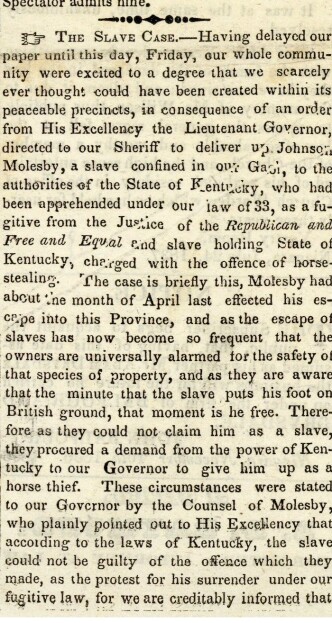
Solomon Moseby
In the spring of 1837, Solomon Moseby, an enslaved man, took his enslaver’s horse and escaped north to Niagara (NOTL) and to freedom. In August, Moseby’s former enslaver arrived in Niagara with a warrant for his arrest and a request for his extradition. The local sheriff took Solomon into custody and placed him in the Niagara District Courthouse and Jail, which was located where Rye Park is today.
While the local authorities thought that they were just doing their job, Solomon, and the hundreds of other freedom seekers living in Niagara, knew that his return would set a precedent. Any freedom seeker could be falsely accused of a crime, be extradited, and be enslaved once again.
The Niagara community was bound and determined to prevent this from happening.
The local white and Black communities submitted petitions to the government to try and prevent Solomon’s extradition. The Black community even offered to pay $1,000, an enormous sum at the time, to secure Moesby’s freedom. His former enslaver refused the money.
Moseby’s lawyer, Alexander Stewart, who was a local resident, wrote to the Lieutenant Governor, stating that this case needed special consideration and that he believed the charge of horse theft was “a mere pretext to obtain his [Moseby’s] servitude in vile bondage”.
Herbert Holmes, a local Black preacher and teacher, and Sally Carter, a Black woman and community leader, sounded the alarm on what had transpired, and soon a group of supporters some 200-400 strong had gathered outside the jail where Solomon was being held. The gathering was peaceful, and the women persuaded the men not to carry weapons.
Solomon’s former enslaver, as well as local Deputy Sheriff McLeod, attempted to commission steamships to carry Moseby across the border. However, Captain Richardson stated that “no vessel commanded by him would be used to convey a man back to slavery”. Other local ship captains also refused to “disgrace their boats”. Even though they declined to participate, this was not the first time that someone was taken across the Niagara River to the United States and conveyed further into slavery.
Forty-four years prior, in 1793, Chloe Cooley was violently bound and put in a boat to be sold across the river in New York. She screamed. She struggled. And she fought back against what was happening to her. So much so that her enslaver, Adam Vrooman, required the help of two other men, Isaac Vroom, one of the sons of McGregory Van Every, and William Grisley. Unlike the aforementioned captains, these men are just as culpable as Adam Vrooman in their participation in Chloe’s further enslavement.
When the order to transport Moseby arrived on September 12, the crowd at the Jail erupted into a riot. Women stood on a bridge to block the road, while others were armed with pitchforks, sticks, flails, and stones. One of the women grabbed the Sheriff and immobilized him in her arms, Herbert Holmes grabbed the reins of one of the horses, and Jacob Green, another Black supporter, pushed a fence rail through the wagon wheel to stop it from moving.
The Deputy Sheriff ordered his constables to fire on the crowd.
Holmes was shot, Green was stabbed with a bayonet, and two others were badly wounded. Green and Holmes died because of their injuries, and they are buried at the Baptist Burial Ground on Mississauga Street.
Amid the kafuffle, Solomon Moseby was able to escape.
Since there wasn’t any clearly enacted legislation to protect freedom seekers, many African Canadians continued to be apprehensive about how safe they were in Canada. In 1838, the law changed so that freedom seekers could not be extradited for crimes that they could not be charged for in Canada. Cases like this one were incredibly important in helping establish Canadian extradition and refugee policies that are still used to this day.
In our history, two people of African descent—Chloe Cooley and Solomon Moseby—were bound and determined to resist their enslavement. So much so that their stories helped enact legislative change that altered the lives of people for generations.
For information on Chloe Cooley, stop in to see our temporary exhibition, Bound and Determined: Chloe Cooley, Enslavement, and the Fight for Freedom. On display until November 14, 2023.



